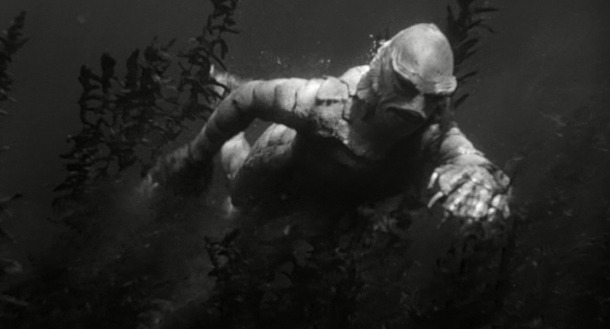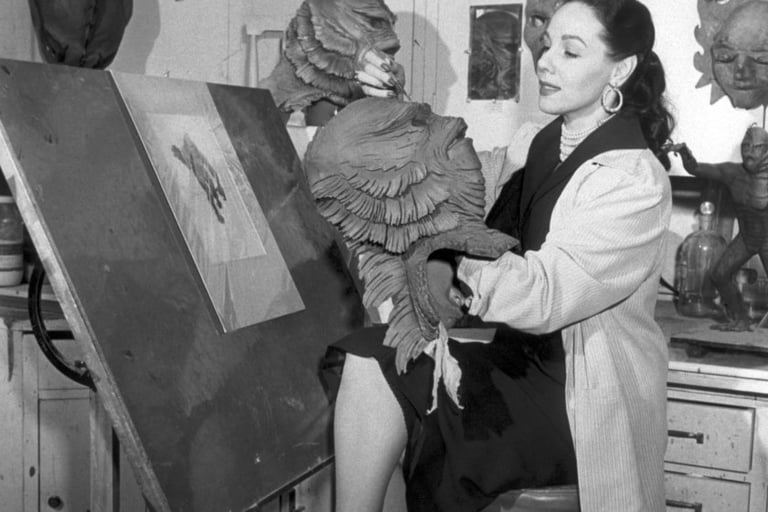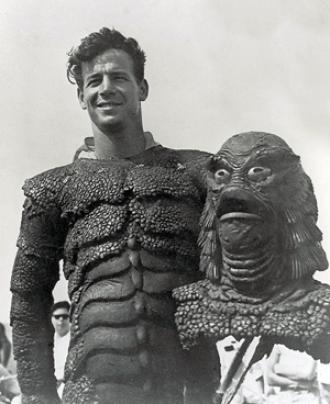Creature from the Black Lagoon (1954)
We didn't come here to fight with monsters. We're not equipped for it. We came here to find fossils.” – David Reed


d so, we flash forward to the mid-1950s. It was a very different world to the one where we left the gothic monsters of the 30s and 40s. Science now ruled, as never before. Science had abruptly ended the second world war with the atom bomb. Mankind was discovering and unleashing forces that he couldn’t control. We had the biggest weapons of mass destruction that the planet had ever seen, yet we still weren’t at peace. The destruction wreaked by those weapons had the after-effect of radioactive fallout, leaving vast areas uninhabitable for several years.
Looking skyward, satellites were launched, there was a race among nations to be the first to leave the planet – and there was a deep hysteria regarding sightings of unidentified flying objects. Technology was marching on – we were truly living in a science fiction age – and that was reflected in the cinema. Atomic mutations, aliens from space, scientific horrors – they all appeared on screen to packed audiences.
But Universal Pictures had one more trick up their sleeve. One more monster, which though not gothic, made his way to the line-up of their legendary monsters. The Gill-Man. A half human, half fish amphibian, unchanged since the Devonian Age who lived in the Black Lagoon, on the Amazon. And humanity being what it is, (inhumane), we just couldn’t leave him alone.
When a geologist discovers a fossilised webbed hand, an expedition is formed to discover the rest of this amazing find, which has presumably washed down river over the millennia. Its discovery will prove the connection between mankind and his aquatic origins.
Of course, what they don’t know is that there’s still at least one of the creatures still alive and thriving down there. So, when archetypal fifties scientist/hero (remember in the thirties and forties when they were all villains?) David Reed (Richard Carlson), his girlfriend Kay (Julie Adams), financier and scheming Mark Williams (Richard Denning) take to the Amazon to look for the rest of the fossil in the tramp ship Rita, they get far more than they bargained for when they meet a living specimen.
The Gill-Man is one of the most iconic, if not THE most iconic monster of the fifties. The costume was designed by an ex-Disney illustrator, Millicent Patrick though for five decades, Universal’s then head of make-up Bud Westmore (who had replaced Jack Pierce) took sole credit. So, let’s take a moment to salute Ms Patrick on her outstanding creation to the world of movie monsters that we love so much.


The Gill-Man was played by two actors – the taller Ben Chapman did the work on land, and for the swimming scenes, it was the shorter Ricou Browning. Browing was a swimming performer born and working in Florida, who could hold his breath for more than four minutes underwater. Think about that for a second – four MINUTES.


Speaking of swimming, Julie Adams, who was a contract player with Universal at the time, did her own stunts – so that was actually her performing underwater with Ricou Browning during one of the most hypnotically choreographed underwater sequences I’ve certainly ever seen in a film. The sequence that Steven Spielberg credits with inspiring him so much when he directed Jaws.
Kay decides to take a swim in the Black Lagoon, not realising that the Creature is nearby, watching. As she’s swimming normally at surface level, the Gill Man is swimming directly underneath her, duplicating her movement as he looks up at her. As she treads water, he reaches out and very nearly touches her foot – but there’s nothing threatening in his actions, it’s very much curiosity that drives him and the whole scene is played like an underwater ballet. Of course, the Gill-Man hasn’t seen a human female before and now, he’s interested.
When they discover that the Gill-Man is there, of course Mark wants him caught and brought back to civilisation so he can make a fortune. (This is why I see Del Toro’s Shape of Water as a sequel to this film, it really is a possible continuation of the same story) and drugs the water render the Creature unconscious so they can capture him. But the Gill-Man is stronger than they think and he breaks free and damn up the lagoon so they can’t leave – also giving himself a good opportunity to abduct Kay.
Unfortunately, his cavernous hangout has already been discovered by David and Mark, so they know where he’s headed and after rescuing his best gal, David watches the bullet riddled Gill-Man sink slowly to the depths.
In many ways, it’s the archetypal monster movie of the fifties, and it’s a great film to watch. It’s more nuanced that you might think, considering the scene where Kay carelessly discards her cigarette in the water, while the Creature watches from below the surface in confused bewilderment. It’s a small and subtle commentary, uncommon at the time, on man’s careless pollution and corruption of everything we touch, everywhere we go.
John Carpenter was rumoured to be filming a remake in the eighties, from a more ecological point of view and I’ve always thought it a shame that the project never came to pass. Despite my love for the original, I’d have liked to have seen his take on the story. After all, it worked well on The Thing, and I’m a big fan of both versions for different reasons.
